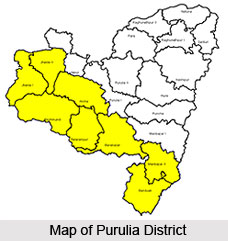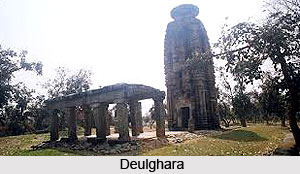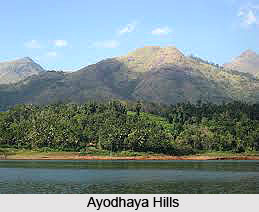 Purulia District is the westernmost district of West Bengal with all-India significance because of its tropical location. The district funnels not only the tropical monsoon current from the Bay of Bengal to the subtropical parts of north-west India, but also acts as a gateway between the developed industrial belts of West Bengal and the hinterlands in Orissa, Jharkhand, Madhya Pradesh and Uttar Pradesh. For its convenient location, this place has acquired an important place in the tourist map in India.
Purulia District is the westernmost district of West Bengal with all-India significance because of its tropical location. The district funnels not only the tropical monsoon current from the Bay of Bengal to the subtropical parts of north-west India, but also acts as a gateway between the developed industrial belts of West Bengal and the hinterlands in Orissa, Jharkhand, Madhya Pradesh and Uttar Pradesh. For its convenient location, this place has acquired an important place in the tourist map in India.
Location of Purulia District
Purulia district is located between 22.60 degrees and 23.50 degrees north latitudes and 85.75 degrees and 86.65 degrees east longitudes. The area wise expansion of the district is 6259 sq.km Towards the east of the district is Bankura and Paschim Medinipur districts, towards the north lies the Bardhaman District of West Bengal and Dhanbad district of Jharkhand , to the west of Purulia is Bokaro and Ranchi districts of Jharkhand state and on the south lies the West Singhbhum and East Singhbhum districts of Jharkhand state.
History of Purulia District
Jaina Bhagavati-Sutra of circa 5th century A.D. mentions that Purulia District was one of the 16 Mahajanapadas and was a part of the country known as Vajra-bhumi in ancient times. However, little is known about Purulia before the East-India Company obtained the `Diwani` of Bengal, Bihar, and Orissa in 1765. By Regulation XVIIII of 1805, a Jungle Mahal district composed of 23 parganas and mahals including the present Purulia was formed. By Regulation XIII of 1833 the Jungle Mahals district was broken up and a new district called Manbhum was constituted with headquarters at Manbazar. The district was very large in size and included parts of Bankura, Burdwan of present West Bengal and Dhanbad, Dhalbhum, Saraikela and Kharswan of present states of Jharkhand and Orissa. In 1838 the district headquarters was transferred to the present district of Purulia of . Since the formation of the district it was withdrawn from regular administration and placed under an officer called Principal Assistant to the agent to the Governor-General for South-Western Frontier. The title of the officer Principal Agent was later changed to Deputy Commissioner by Act XX of 1854. Finally in 1956 Manbhum district was partitioned between Bihar and West Bengal under the States Reorganization Act and the Bihar and West Bengal (Transfer of Territories) Act 1956 and the present district Purulia was born on 1st November, 1956.
 Geography of Purulia District
Geography of Purulia District
Maximum Rainfall in the district is received from the south-west monsoon. The average annual rainfall of the district is between 1100 mm and 1500 mm. The relative humidity of the region is as high as 75 percent to 85 percent but during hot summers the humidity level declines. Temperatures become as low as 7 degrees centigrade in winter and 46 degrees in summer. The prominent rivers of Purulia District are Kangsabati, Kumari, Dwarakeswar, Subarnarekha River and Damodar River. The soil that is found in the district is mostly residual soil.
Demography of Purulia District
As per 2001 census total population of the district is 2535516, out of which 89.93 percent are residing in rural areas and 10.07 percent are in urban areas. About 51.18 percent of the populations are males and 48.82 percent are female. More number of males are literate than the number of females in the district. Around 74.18 percent males are literate in comparison to only 37.15 percent females. The percentage of Scheduled Caste and Scheduled Tribes are 18.29 percent and 18.27 percent. Total no of BPL families in rural areas of this district are 197381 (43.65 percent). Out of which SC families are 40645 (20.59 percent) and ST families are 47666 (24.15 percent).
Education in Purulia District
The standard of education in Purulia is uplifted primarily by the educational schemes conceived by the government in the recent times. The initiation of the elemental education and the primary schools induced the foundation of education in Purulia. There is 2998 primary school in Purulia.

The post Literacy campaign in Purulia started in 1996-97 had already been completed in the year 2002. The success of this campaign results in the effective development in the education in Purulia. At present the district has 11 Degree colleges, one B.ED College, one Polytechnic College and one industrial training Institute.
Administration of Purulia District
In the district of Purulia District Magistrate is the head of the District Adminitration. He is also the District Collector and also Executive Officer of Zilla Parishad. He is assisted by the Additional District Magistrate (General), Additional District Magistrate (Development), Additional Executive Officer, Additional District Magistrate and D.L. and L.R.O, S.D.O (Sadar East), S.D.O. (Sadar West), S.D.O. (Raghunathpur), B.D.O.s of 20 Blocks and by other Officers.
The various administrative units of Purulia are Purulia Sadar East, Purulia Sadar West and Raghunathpur.
Economy of Purulia District
The economy of Purulia District is solely dependant on the industrial sector. In fact Large-scale industries are the base of the district`s economy. There are also medium-scale and small-scale industries in the region. Some part of the population in the district also thrives on cultivation and some of them are also engaged in fishing activities. Apart from these the Purulia District is a haven for tourists and as a result the local people of the districts are able to make some business from the tourists.
Tourism in Purulia District
Tourism in the district of Purulia is well flourished. There is other archaeological place of interest in the district as well. Temples in Deulghera are popular for their architecture. The terracotta sculptures on the temples of Purulia district are outstanding. The hills, waterfalls and dams also serve as major attractions in the district of Purulia. Purulia is easily accessible by road and by train from any part of the rest of the India. It is 295 Km away from Kolkata towards west and 119 Km from Ranchi towards east. The National Highway - 32 and National Highway - 60 passes through the District. SBSTC, CSTC, NBSTC buses and many privately operated buses ply between Kolkata, Ranchi, Dhanbad, Bokaro, Asansol, Durgapur to Purulia.






